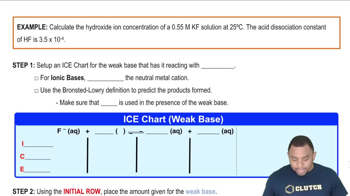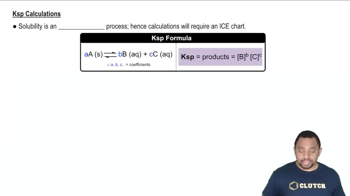Use the given molar solubilities in pure water to calculate Ksp for each compound. b. Ag2SO3; molar solubility = 1.55⨉10-5 M c. Pd(SCN)2; molar solubility = 2.22⨉10-8 M
Ch.17 - Aqueous Ionic Equilibrium
Chapter 17, Problem 93
Refer to the Ksp value from Table 17.2 to calculate the solubility of iron(II) hydroxide in pure water in grams per 100 mL of solution.
 Verified step by step guidance
Verified step by step guidance1
Identify the chemical formula for iron(II) hydroxide, which is Fe(OH)_2.
Write the dissolution equation for Fe(OH)_2: Fe(OH)_2 (s) \rightleftharpoons Fe^{2+} (aq) + 2OH^{-} (aq).
Express the solubility product constant (K_{sp}) for Fe(OH)_2: K_{sp} = [Fe^{2+}][OH^{-}]^2.
Let the solubility of Fe(OH)_2 be 's' mol/L. Then, [Fe^{2+}] = s and [OH^{-}] = 2s.
Substitute these expressions into the K_{sp} equation and solve for 's'. Convert the solubility from mol/L to grams per 100 mL using the molar mass of Fe(OH)_2.
Key Concepts
Here are the essential concepts you must grasp in order to answer the question correctly.
Solubility Product Constant (Ksp)
The solubility product constant (Ksp) is an equilibrium constant that applies to the solubility of sparingly soluble ionic compounds. It represents the maximum concentration of ions in a saturated solution at a given temperature. For iron(II) hydroxide, Ksp can be used to determine the solubility by setting up an equilibrium expression based on the dissociation of the compound into its constituent ions.
Recommended video:
Guided course

Solubility Product Constant
Dissociation of Iron(II) Hydroxide
Iron(II) hydroxide (Fe(OH)2) dissociates in water to form iron ions (Fe²⁺) and hydroxide ions (OH⁻). The balanced equation for this dissociation is Fe(OH)2 (s) ⇌ Fe²⁺ (aq) + 2 OH⁻ (aq). Understanding this dissociation is crucial for calculating the concentrations of the ions in solution, which are needed to apply the Ksp expression.
Recommended video:
Guided course

Hydroxide Ion Concentration Example
Calculating Solubility from Ksp
To calculate the solubility of iron(II) hydroxide from its Ksp value, one must set up the Ksp expression based on the dissociation reaction. For Fe(OH)2, Ksp = [Fe²⁺][OH⁻]². By substituting the solubility (s) into this expression, where [Fe²⁺] = s and [OH⁻] = 2s, one can solve for s, which represents the solubility in moles per liter. This value can then be converted to grams per 100 mL of solution.
Recommended video:
Guided course

Ksp Calculations
Related Practice
Textbook Question
Textbook Question
Two compounds with general formulas AX and AX2 have Ksp = 1.5⨉10-5. Which of the two compounds has the higher molar solubility?
Textbook Question
Consider the compounds with the generic formulas listed and their corresponding molar solubilities in pure water. Which compound has the smallest value of Ksp? a. AX; molar solubility = 1.35⨉10-4 M b. AX2; molar solubility = 2.25⨉10-4 M c. A2X; molar solubility = 1.75⨉10-4 M
Textbook Question
The solubility of copper(I) chloride is 3.91 mg per 100.0 mL of solution. Calculate Ksp for CuCl.
Textbook Question
Calculate the molar solubility of barium fluoride in each liquid or solution. a. pure water
Textbook Question
Calculate the molar solubility of barium fluoride in each liquid or solution. b. 0.10 M Ba(NO3)2
